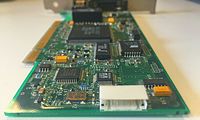
Photo from wikipedia
Driven by the rapid development and application of earth observation sensors, the scene parsing of remote sensing images (RSIs) has attracted extensive research attention in recent years. Restricted by the… Click to show full abstract
Driven by the rapid development and application of earth observation sensors, the scene parsing of remote sensing images (RSIs) has attracted extensive research attention in recent years. Restricted by the limited local receptive field of successive convolution layers, traditional models of scene parsing cannot effectively and interactively utilize the local-global information and digital surface model (DSM) of RSIs. Comparatively, accurate scene parsing faces more challenges because of unbalanced categories, small targets, and more complex scenes. To address these challenges, herein, we propose a novel adjacent bi-hierarchical network (ABHNet). Specifically, we introduce a DSM-enhanced (DSE) module to excavate characteristic DSM information from DSM images and enhance the red, green, and blue (RGB) features by exploiting informative cues between RGB and DSM modalities. In addition, an adjacent context exploration (ACE) module is proposed, which contains current and adjacent branches. The branches first exploit multiscale complementary characteristics of multilevel features and then integrate these features by applying adjacent exploration. Our model includes five ACE modules—three are deployed to activate detailed features and two obtain deep-guided features. The mutual collaboration of deep and detailed features is more beneficial to the segmentation of small objects. Extensive experiments on two remote sensing benchmark datasets (ISPRS Potsdam and Vaihingen) showed that the proposed ABHNet qualitatively and quantitatively outperformed other methods.
Journal Title: IEEE Geoscience and Remote Sensing Letters
Year Published: 2023
Link to full text (if available)
Share on Social Media: Sign Up to like & get
recommendations!